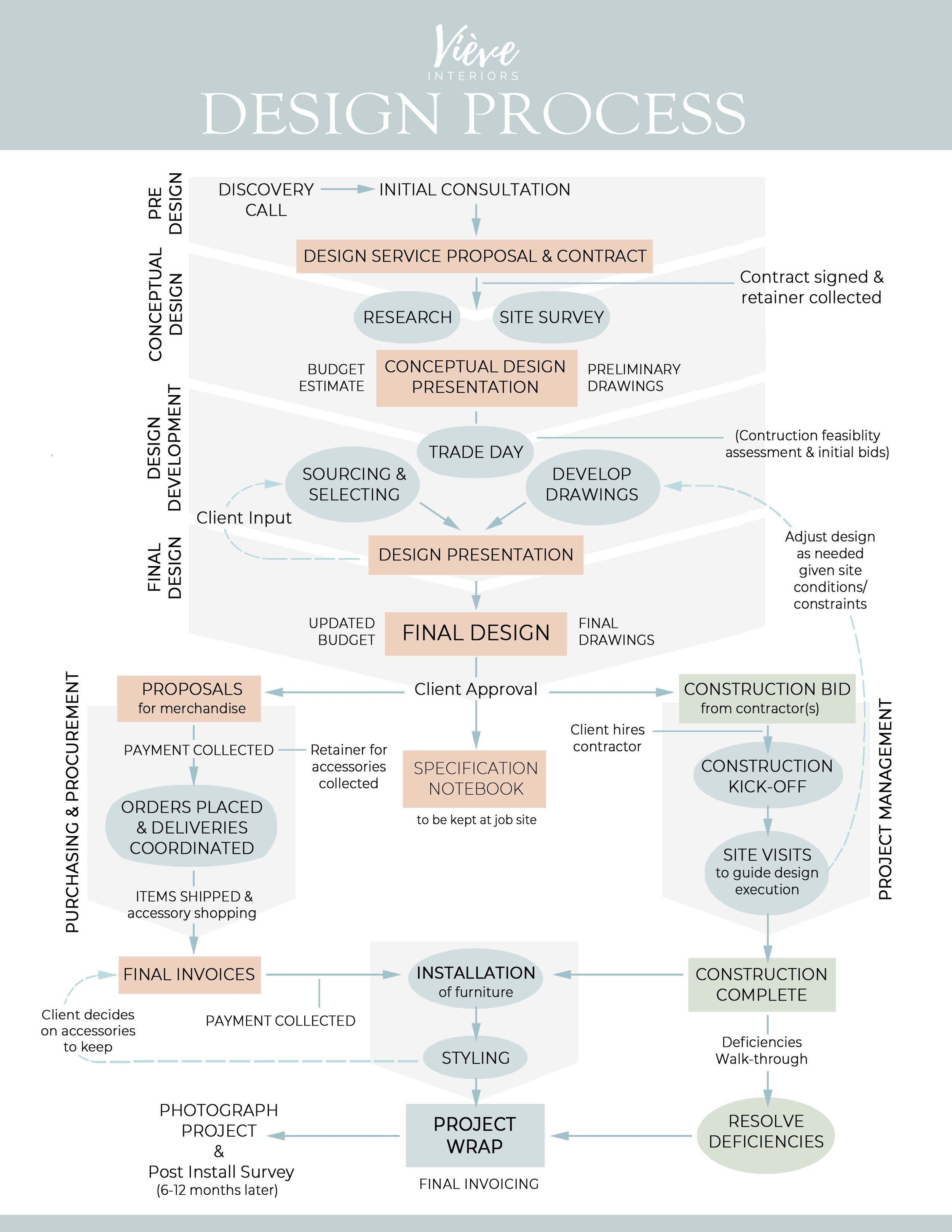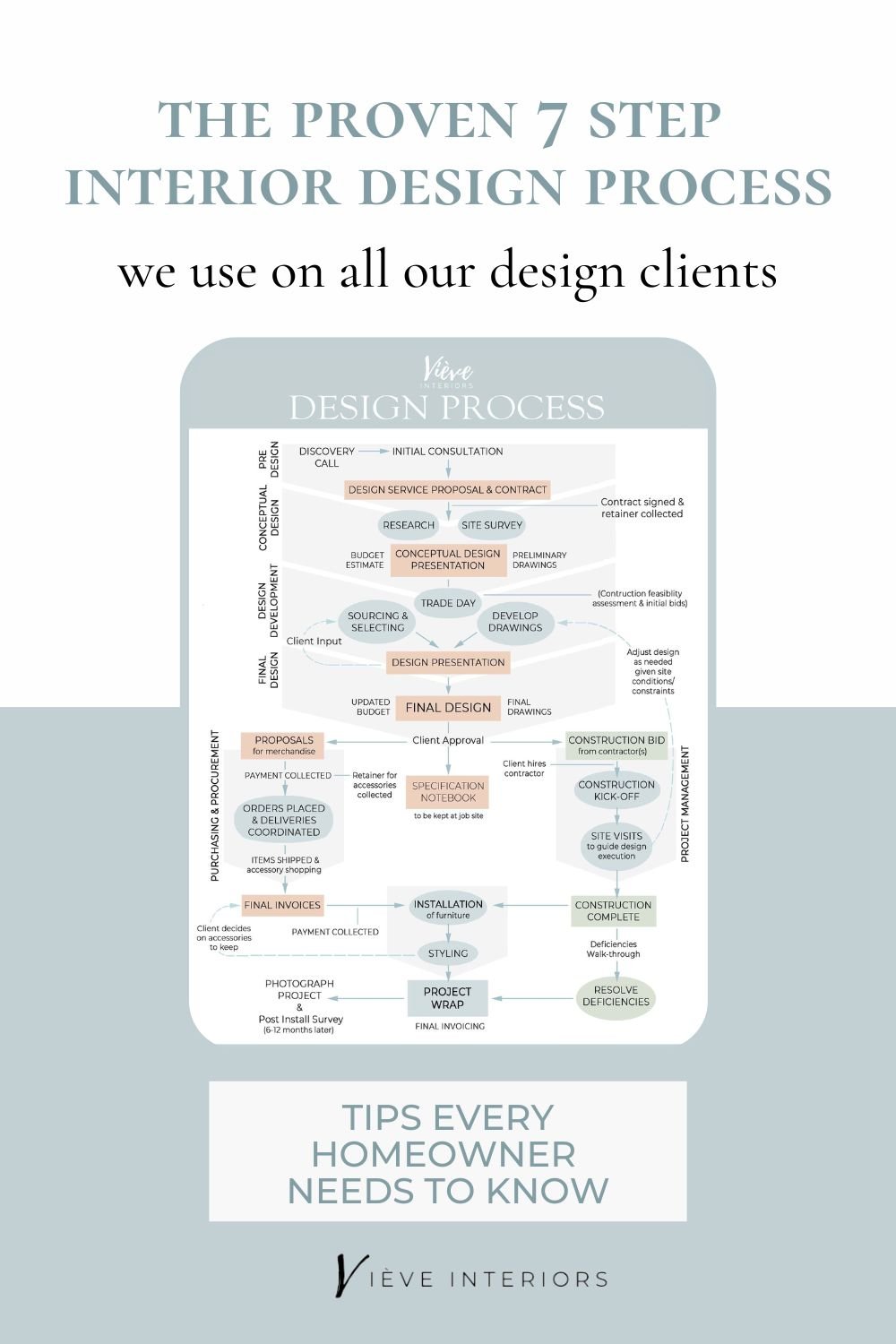

I know what I like, but I just don’t know how to make it all come together. We hear this so often from our clients. This means it’s time—time to tap out (so to speak) and tap in a qualified interior designer! Working with an interior designer eliminates the stress and overwhelm, eases the process of remodeling and building homes, improves the functionality of your living space, and transforms your personal style and goals into a beautiful, cohesive home.
If this is your first time working with an interior designer, you may be curious about the process. You’re in the right place. We’ve created a step-by-step guide for working with an interior designer to help you develop a good understanding of the interior design process before you begin.

Step One: The Discovery Phone Call
The first step in the interior design process is to get to know your potential interior designer with a discovery call. This initial meet-and-greet is the perfect opportunity for both you and the interior designer to determine if working together is a good fit.
Your choice of interior designer shouldn’t be based solely on design style. While good style is obviously a determining factor, it is important to remember that if design principles like balance, rhythm and repetition, contrast, and proportion, are well thought out , your space will come together in a cohesive way no matter what design style you choose. So, find someone who:
Once you are confident you have found a perfect match for your redesign, it’s time to schedule your in-person, on-site consultation.
Step Two: In-Person, On-Site Consultation
The in-person, on-site consultation kicks off the start of your project (yay!). Each design firm does things a little differently, but our initial consultation typically lasts two hours and is a paid service. During your consultation, you will start to have conversations about functionality and style. This is your time to tell your designer all your hopes and dreams for your space! Your designer may make some suggestions or have some design ideas to consider, but this meeting is largely about gathering as much information as possible to understand your needs. This is also when your designer will go over the entire design process and your contract.
Step Three: The Conceptual Design Phase
Time to get excited—during the conceptual design phase, your designer is hard at work putting together their big vision for your home! The designer will complete a site survey to take measurements and photos of your space. You are also likely to receive access to a shared Pinterest board during this phase so that you and your designer can start to get inspired.
This phase is also the time when initial floor planning begins—to develop good flow patterns and add desired features into your home. If you opted to work with a designer who also has a technical background, you will likely see preliminary AutoCAD drawings of initial floor plans for full remodels and some options for furniture space plans.
At the end of this phase, your designer will meet with you to review the initial plans, conceptual design ideas, and an estimated budget to ensure they are on track with the design intent.
Step Four: The Design Development Phase
After the initial plans are approved, the design development phase begins. This phase is kicked off with a “trade day” in which your interior designer will review the preliminary design ideas with the contractor and tradesmen to get initial bids for construction.
Next, your interior design team will develop all drawings and iron out all the specifics (every little detail) while simultaneously sourcing all materials, fixtures and furnishings. They will carefully select everything for your newly renovated home, including:
You get the idea! Once the refined plans for your design are complete and selections are made, your designer will request pricing from vendors and update the budget as well as the timeline.
At the end of this phase, you will meet with your interior designer to review a finalized design presentation, tear sheets, and the physical material samples. This design plan will be the most finished product up to this point. If something is not approved, the designer will reselect items, refine any construction drawings, and present you with the updated design. Once everything is approved, we move onto the final design phase.
Step Five: The Final Design Phase
In the final design phase, a few big things are happening. First, your interior designer will create a specifications notebook for the general contractor (to be left at the job site) that includes all floor plans, along with specification sheets of finishes, fixtures and furnishings. All final drawings will be given to you, the general contractor, and any trades necessary. If the general contractor has not done so yet, this is the time they will obtain any required permits.
Additionally, your designer should begin collecting accessories to be able to complete your design once construction is finished. At Viève Interiors, we compile a list of accessories and final touches needed and then collect a retainer before purchasing what we need to style out your home. Once that is done, “purchasing and procurement” of all merchandise will begin. The interior design team will coordinate all deliveries and, when necessary, work with a receiver who will make sure everything is in great condition.
The final design phase will also include a lot of project management tasks. For example, the interior designer should host a walk-through meeting with the contractor to kick off construction, and then make periodic visits to the site to ensure design execution is going as planned. Inevitably, issues may arise, in which case your designer should always be looking for solutions and adjusting plans and drawings when needed.
During this final design phase, the designer will also verify locations of light fixtures, tiles and other flooring, refine details on site, and coordinate additional vendors (like an upholster, wallpaper installer, or window treatment workroom).
Step Six: Installation and Styling
Finally, the stage when we get to see it all come together! Once construction is complete, your interior design team will schedule a time to take photographs and will install all furniture and décor. At this point, you get to decide what accessories you want to keep and what you want to return. It’s so fun!
Step Seven: Project Wrap
After a long journey, the day has finally come for the last walk through—yay! To make sure that you are totally and completely in love with your new home design, your interior designer will walk through your space with you and note any deficiencies that need to be resolved, while coordinating solutions. This is also the time where your designer will take pictures of your beautiful home and give you the final invoice. If you are happy with your new remodel, it’s the perfect opportunity to give your interior designer a few referrals or a raving review!

We hope that you have gained a better understanding of the interior design process! If you have questions, or would like to book a discovery call, call 949-610-7800 or fill out the contact form and we will reach out to you directly!
At Viève Interiors, it is our mission to help homeowners love where they live because happy homes are the most beautiful homes!